|
'This is more of a folk style recipe, requiring more eyeballing than measuring, so tap into your inner kitchen witch and get cookin'! Add 1 quart of freshly harvested elderberries and 1/3 c of filtered water to a pot. Bring to a gentle boil then quickly reduce to a simmer (uncovered) for about 15 minutes, until the berries are very soft and your house is fragrant. Remove from heat and let cool a bit before adding to a food processor or blender (this is an extra step that I think really kicks the flavor and medicine up a notch). Blend well and then strain out the seeds and stems using a sieve or colander over a bowl. Compost the solids and add the purple liquid back to the pot along with ~2 tbsp fresh or ground ginger and 10 green cardamom pods. Bring back to a simmer and reduce by half, about 15-20 min. Remove from heat and strain out the ginger and cardamom directly into a measuring glass, At this point, you want to measure the reduced juice so you can add equal parts of honey*. Mix well and let cool completely before bottling. Store in the fridge for up to 3 months. Take 1-2 tbsp throughout the day at the first sign of a cold. *it's important that honey isn't exposed to temperatures over 104 F lest some important enzymes be destroyed.
Tahini is one of our most cherished ingredients - it's versatile, affordable, and loaded with health benefits. It is equally delicious in desserts, main dishes, breads, or by the spoonful for a quick snack (goes great with honey & sea salt if enjoying it this way!). This creamy "nut butter" made from sesame seeds is a fraction of the cost of almond butter - with a much smaller environmental impact! Though from a tiny seed, tahini's nutrient density is impressive: -Compared to other seeds and nuts, sesame seeds have a very high fat (55%) and protein content (20%) by weight. -Tahini is also particularly high in minerals, especially iron and copper. Studies have affirmed that tahini is a heart healthy food: it's high in lignans and its 2 primary fat compounds- sesamin and sesamolin- have showcased anti-thrombotic effects. So let's get to the good stuff - our Ta-honey Mustard Recipe! This sauce goes great as a dressing or a dipping sauce for meats, veggies, or chips! Ta-Honey Mustard Recipe In an 8 oz mason jar, add ½ cup tahini and 2 tbsp apple cider vinegar. Stir together; as you stir the acid from the vinegar will react with the proteins in the tahini and make the mixture very thick. Stir in filtered water (~3 tbsp to ¼ cup, depending on the runniness of your tahini) until the consistency is silky smooth like Ranch dressing. Next, add 1 tbsp of garlic fermented honey* (regular honey will do), 2 tsp dijon mustard (or more if you are a mustard lover), 1 tbsp turmeric powder and a hefty pinch of salt and pepper to taste. This recipe is flexible - add more or less of anything to achieve your desired blend. garlic fermented honey* recipe below! Garlic Fermented Honey Recipe
Loosely seal the filled jar with a lid (we like these!) and let sit at room temp away from direct sunlight. The slightly loosened lid will allow fermentation gases to escape. Every other day or so, tip the jar upside down a few times (make sure you fully seal the lid when you do this!) to circulate the honey. You will start to see tiny bubbles indicating that fermentation process is at work! This alchemical process will begin around day 3 and continue for 1 month, but you can enjoy the honey at any time during this period. You will notice the flavor and texture develop over time - the garlic's pungency will mellow and the honey will become runnier.
Store in a cool, dark place for many moons. If kept sealed and away from heat and light, it can easily last 1 year or more! After I use up all the honey, I like to blend up the cloves in pestos and other sauces. As herbalists and nutritional therapy practitioners, we relish in the interface between nourishing herbs and foods. We adapted this recipe to be fitting for our students in the Restart Program, a guided 3-week vacation from sugar and processed foods. During this time, we retrain our bodies to burn fat - its preferred fuel - over carbs - the macronutrient that has been villianized by current fad diets but that actually holds tremendous value when consumed in the proper amounts (there is a that reason sweets taste so good!). The addition of rose hip and licorice powder give a delightful herbal touch to these satisfying chocolates. Licorice (Glycyrrhiza glabra) is known as the great harmonizer in several herbal traditions for its ability to enhance and round out the flavor and action of other herbs in formula. A little bit goes a long way with licorice, so treat it like you would sea salt. Rose hips (Rosa ssp.) are excellent cardiovascular aids and give a bright touch to the deep richness of the cacao. Raspberry Rose Chocolate Recipeketo, paleo, no-sugar, delish! Ready in 15-20 min (10+ minute chill time) INGREDIENTS ¾ c coconut butter ¼ c coconut oil ¼ c grass-fed butter 3 tbsp cacao powder 1 tsp vanilla Sea salt ½ c coconut butter ½ c frozen raspberries 2 tbsp coconut cream/milk 1 tbsp rose hip powder 2 pinches licorice powder 2 tsp maple syrup Sea salt 1 c toasted, shredded coconut RECIPE
Chocolate Base In a small pan, add ¾ c coconut butter, ¼ c grassfed butter, ¼ coconut oil, 1 tsp vanilla, and 4 tbsp cacao powder, and a pinch of sea salt and heat on medium low until everything is melted. Stir until everything is combined. Remove from heat. Set aside. Raspberry Filling 1. Filling-In a small saucepan mix together ½ c coconut butter, ½ c raspberries, 2 tbsp coconut cream/milk, 1 tbsp rose hip powder, 2 tsp maple syrup, and a pinch of salt on med-low. Heat until coconut butter is melted and incorporating into the raspberries. Pour ingredients into a blender or use an immersion blender to blend well. Set aside. Using a silicon ice cube tray, pour the bottom ½ of each cube with the chocolate mixture. Put this in the freezer so it is resting evenly and the chocolate sauce doesn’t cool crookedly in the ice cube molds. Let freeze for at least 10 minutes until the chocolate is set. Remove from the freeze and spoon ~1 tsp of the raspberry filling into each cube mold. Press ~½-1 tsp of toasted coconut flakes into the raspberry filling. Pour the remaining chocolate sauce over each mold so that the raspberry and shredded coconut filling is covered. Return to the freeze for another 10 minute at least to let that set. Remove from freezer and dust in a combination of cacao and rose-hip powder or toasted coconut. OPTIONAL Add 1 tbsp maple syrup to the raspberry filling and/or Add 2 tsp maple syrup to the chocolate base The keto diet is buzzing right now, but what exactly does it mean, and is it for everyone? Well, ketosis is pretty cool for a number of reasons. Whether you are aware of it or not, your body has likely entered ketosis from time to time. We enter ketosis in 2 scenarios: -when we deprive our bodies (almost completely) of glucose -when we fast for ~12-15 hours Ketosis isn't an all or nothing deal. We can be in mild or full-fledged ketosis, or not at all. When glucose isn't available as a result of one of the above scenarios, Ketones are created as an alternate fuel. At this point, some interesting things happen. In even mild ketosis, our antioxidant production is ignited (up to 150 g antioxidants/day). Ketosis also stimulates the production of beta hydroxybutyrate, the ultimate source of fuel for mitochondria. These guys are the powerhouses of our cells and when they aren't firing correctly, you can expect disease to set in. Ketones help mitochondria produce ATP. By increasing ATP, ketones reduce the generation of free radicals, increase production of endogenous glutathione, and act as an anti-inflammatory agent. Ketones also reduce inflammation and oxidation throughout the body but especially in the brain. This is because the brain rapidly takes up ketones, an easily digestible fuel source that is small enough to cross the blood brain barrier (the liver converts MCTs to ketones). If ketones are present even at low levels they increase cerebral blood flow as much as 40%. Studies have shown that increasing ketones is a great strategy to block ionizing radiation and for controlling tremors. To maximize ketones: -Reduce carbs. This doesn't have to look like cutting them out completely. In fact, having such a stark transition from a carby diet to none at all can cause some crazy symptoms like the carb flu, the keto rash, and other undesirable effects. Be gentle with your body and remember that it doesn't like extremes but rather thrives in moderation. We like to follow the diet recommended through the RESTART program, allowing for non-starchy vegetables and low sugar fruits while avoiding starchy carbs, refined sugars, grains, and processed foods (RESTART will be offered again in January 2020 Athens, GA peeps!) -Use a form of intermittent fasting by eating in a 6-8 hour span. This could look like not eating after 7 pm and waiting until 11-noon to eat your first meal the next day. Use MCT oil, grass fed butter, coconut butter, or coconut oil in your coffee or tea to sustain you until your first meal -make these keto muffins! Recipe below :) KETO MUFFINSIngredients6 large eggs 1/4 c olive or toasted sesame oil ½ cup tahini (on the runnier side is best-we love this kind) 1 c raw cashews ½ c raw pumpkin seeds 2 tsp apple cider vinegar 1 tsp sea salt 1 tsp baking soda 1/4 tsp baking powder Sesame seeds and/or pumpkin seeds to garnish DirectionsPreheat oven to 350. Use butter and almond flour to grease and flour a muffin tin.
Add all ingredients listed in order to a food processor or high powered blender. Blend well until you have a completely smooth, creamy batter. Use a spoon to drop the batter into the greased and floured muffin tins. I find a spoon the easiest tool to work with. Continue adding more batter until all 12 muffin holes are filled up (all the batter should be used up at this point). Top with sesame and flax seeds and put on middle rack in oven for 35 minutes. Let cool for 10 minutes before popping out your muffins. Let cool completely before storing in an airtight container in the fridge for a few weeks or the freezer for much longer. They will last on counter for 3 days. I like to have these on hand for a quick breakfast with an egg or smothered in your favorite nut butter.  When we make dessert we like to make sure of a few things. It's paired with: 1. Lots of good fat Fat slows down the absorption of sugar. This means two things: we stay satisfied longer and we don't overburden our organs- especially the pancreas. The pancreas is an incredible organ taxed with the huge responsibility of getting sugar out of the blood. When we have too much sugar in the blood, those sugars bind with our blood cells rendering them clunky, ineffective and hazardous to our entire body. So basically, always eat fat when you eat sugar! We like grass-fed butter, ghee, and unrefined coconut oil for our saturated fats and extra virgin olive oil, avocado oil, and sesame oil for our unsaturated fats. 2. Sugar stabilizing herbs In many clinical trials, Ceylon Cinnamon (Cinnamomum verum) has been shown to: promotes glycemic control, improve lipid parameters, reduce insulin resistance, and improve insulin action (Ranasinghe et al, 2012). It's likely no coincidence that cinnamon and sugar is a traditional combination. Our ancestors knew what was up! 3. Adaptogens! This class of herbs could possibly be one of the modern human's greatest herbal allies. Adaptogens work by improving our body's perception of and response to stress, making us more resilient in the face of it. Think of it this way- we can't always control the amount of stress going on in and around us, but we can certainly control how we respond to these stressors. Our bodies are always responding to stressors large and small, emotional and physical, whether we are aware of it or not (if you haven't noticed, our bodies are really good at acclimating to sub-optimal environments and our minds are really good at distracting us from listening). And the truth is- the modern world barrages us with constant, low-level stressors that our ancestral bodies have simply not adapted to handle. These chronic low-level stressors mean that our bodies are always pumping out stress hormones, leaving us depleted in some capacity at some point in time. Depression, autoimmune conditions, fatigue, inflammation, mood disorders, hormonal issues, lack of vigor- many argue that all these things could be traced back to chronic, low level stress (Sapolsky, 2004). Adaptogens have been utilized by our ancestors in some form across the globe. They are tonic level herbs (meant to be taken regularly) that produce a non-specific response in the body (they increase our resilience to numerous stressors) while also having a normalizing effect (balancing us out no matter the direction we favor) (Winston & Maimes, 2007). Science is in the midst of catching up to the magic of adaptogens, but the verdict is out: adaptogens rock! They come in all shapes and sizes and address countless modern complaints. An important note on taking adaptogens: best practice is to stop any adaptogen routine during times of acute illness such as the flu. IngredientspinCAKE 1.5 sticks grass-fed butter 6 oz chopped bittersweet bakers chocolate 1 tsp instant coffee 1 tsp vanilla 1 tsp ceylon cinnamon 1/4 tsp licorice powder 2 tbsp red Reishi powder 1 tbsp Shatavari powder 4 large eggs room temperature 1/2 c raw sugar healthy pinch of sea salt 1/2 cup raw cacao GLISTENING GANACHE 1 c heavy cream (coconut cream can work too!) 12 oz bittersweet chocolate pinch sea salt DirectionsCAKE Preheat oven to 325 F. Cut out a piece of parchment paper to fit a circular 8” pan. Place paper into pan. Set aside. Melt butter in a saucepan at a medium low heat. Add the Reishi and Shatavari, stirring constantly as the herbs infuse into the butter, about 5 minutes. Remove butter mixture from heat and add chocolate chips. Stir until smooth. Add the instant coffee and vanilla extract and set aside. Whisk or mix eggs, sugar, and salt until your mixture has grown in volume (this takes around 5 minutes with a hand mixer). Next, slowly add your chocolate-butter mixture as you continue mixing. Fold in cacao, cinnamon, and licorice. Mix until completely combined. Pour the batter into your prepared pan. Bake for 30 minutes at 325. The edges should appear "baked" but you want the center a bit gooey still. Remove from oven and cool at room temperature completely before transferring to a fridge. Let chill for 5 hours. GANACHE Bring 1-2" water to a low boil/simmer in a sauce pan. Top with a double boiler. Add chocolate and cream to the double boiler and let melt, stirring occasionally until you have a smooth consistency. Add a pinch of sea salt. Drizzle over your chilled cake until it's completely covered. Chill again for another hour. Serve with whipped cream and enjoy! Resources Engels, Gayle & Brinckmann, Josef. 2012. HerbalGram: Cinnamon, Issue 95. American Botanical Council Ranasinghe, P., Perera, S., Gunatilake, M., Abeywardene, E., Gunapala, N., Premakumara, S., ... & Katulanda, P. (2012). Effects of Cinnamomum zeylanicum (Ceylon cinnamon) on blood glucose and lipids in a diabetic and healthy rat model. Pharmacognosy research, 4(2), 73. Sapolsky, R. M. (2004). Why zebras don't get ulcers: The acclaimed guide to stress, stress-related diseases, and coping-now revised and updated. Holt paperbacks. Winston, D., & Maimes, S. (2007). Adaptogens: herbs for strength, stamina, and stress relief. Inner Traditions/Bear & Co. "Soasted Nuts = Soaked + Toasted "Is nothing is sacred anymore? Sometimes it feels this way when it comes to food: one day your swapping out your jerky for raw nuts and raisins because your on a health kick only to find out that dried fruit is high histamine and raw nuts damage your gut. Or maybe you switched out your morning bacon and eggs for oatmeal to learn that anti-nutrients in the oats are causing that bloating and brain fog you started experiencing. But you are just trying to be healthy? Why has everything gotten so complicated? Well we are here to decode some health food conundrums and provide tools to help you eat your way to your best life! Here's the Truth1. Our agricultural systems are colluded with chemicals 2. Our modern food processing techniques render once nutritious foods potentially deleterious to health. 1. Our modern food supply chain is messed up. We are fortunate that most of us have access food in the US, but that doesn't negate the fact that our agricultural systems are tainted with chemicals disturbing our body's natural function. It's not coincidence that the rate of autoimmunity has sky-rocketed in recent years, perfectly paralleling our unparalleled us of dangerous herbicides in agricultural production. Take the highly contentious weed-killer, glyphosate. The US sprays more of this stuff than any other country at over 1.8 million tons every year. Glyphosate, or Roundup, is present in 90% of foods tested by the government (this includes honey!). Once in the body, glyphosate mimics glycine - a foundational amino acid our immune system uses to keep us healthy. Learn more about the crops most heavily sprayed with glyphosate here. 2. Modern industrial food processing techniques are not helping. Canned beans, cereals, and oily roast nuts may be convenient but they are not doing us any favors. These processes may mimic the way our ancestors prepared food, but they simply aren't the same and could be an underlying cause to your health concerns. Take a bouillon cube. In one MSG & sodium soaked golden cube, we have replaced the art of creating broth. Real broth made with bones and veggie slowly simmered for long periods of time, is one of the most universally nutritious foods humans have ever created - a far cry from what's in most store-bought soups today. In today's world, the classic sick food- a can of Campbell's chicken noodle soup - is probably doing more damage than good for someone trying to get well. Just look at the ingredients: Wheat (glyphosate), Eggs, Niacin, Ferrous Sulfate, Thiamine Mononitrate, Riboflavin, Folic Acid, Chicken Meat, Contains Less Than 2% Of: Salt, Chicken Fat, Water, Monosodium Glutamate (MSG, glyphosate), Cornstarch (glyphosate), Modified Food Starch (basically MSG), Dehydrated Chicken Broth, Cane Sugar (why?) The same goes for "heart healthy" nuts. Most nuts sold in the store these days are roasted at high heat in nasty rancid vegetable oil - a far cry from something that is heart healthy. Raw nuts are a step better but our ancestors weren't eating raw nuts by the handful like advertisements would tell us is a good idea, no matter who you are. What is a Nut?Nuts is a blanket term for a TON of different nuts, seeds, beans, and pseudo nuts that we clump together as one food category when in fact, they are all quite botanically unique. For example, certain brands will put cashews, almonds, and peanuts together and call it a "nut mix" when these 3 foods represent incredibly diverse plants- one is a tree, one is a bean, and one is an exterior seed (check out Cashew apples- pretty crazy!). This means that some "nuts" might work fine with you, but others might be very irritating. Many people have allergies or sensitivities to some "nuts" but not others (which is a dangerous situation when you buy these "nut mixes"). Many nuts are also high FODMAP which means it can cause digestive distress in some individuals. "Nuts" contain a TON of potential energy. Remember, a little walnut was meant to become a massive walnut tree one day. Plus "nuts" have been pegged as the ultimate health food, making people much more likely to over-indulge in handfuls of these potent tree droppings because they are "healthy". This has a doubly deleterious effect: excessiveness in any form or fashion is the antithesis to health AND you are consuming a ton of potential energy that will eventually wreck havoc on your metabolism and digestive system. Neither is ideal. Sometimes the roasted nuts are "dry roasted", meaning no extra oils have been added. However, they are often roasted at exceptionally high heats that damage their delicate fats & denature proteins. More often than not, these nuts are roasted in one of the following oils : soybean, cottonseed, canola, rapeseed, or sunflower. While these oils are called "vegetable oils" to entice us into thinking they are healthy, they are major inflammatory agents in the modern diet... and they are EVERYWHERE! These oils are often rancid and degraded. The compounds in veggie oils, naturally protected by the seed/nut's outer coat, are incredibly sensitive to light and heat (for a gruesome analogy, think of how sensitive we would be to the light if we scrubbed away our protective skin- ouch!). The modern processes that produce these oils strip the seed (often using caustic solvents) and expose it to light & heat - the very things that destroy their fragile compounds and fats. Not only do these oils rancidify quickly, but they are often stored in clear plastic bottles exposed to heat during storage and transportation, and we all know that hot plastic means leaching of plastic-y stuff into the oil. No thanks! They are exceptionally high in inflammatory Omega 6s. While Omega 6s are an essential fatty acid that serve an important role, they are highly inflammatory when out of balance with Omega 3s. Since every processed food has some form of these veggie oils, we are operating at a major imbalance. Consider this: We function best with an Omega 3:6 ratio of 1:1. The Average American is working with an inflammatory ratio of 1:20!!! Store-bought nuts typically come in two categories = raw or roasted.Raw nuts don't have the dangers of being roasted in rancid oils, but they do contain naturally occurring anti-nutrients. Anti-nutrients represent a variety of phytochemicals that plants produce to protect themselves from predation and degradation. Historically, our ancestors used gentle means to dissolve these anti-nutrients, like soaking and slow roasting (aka, SOASTING) their nuts for optimal nutrition and ease of digestion. Take phytic acid. This form of bound-phosphorous serves to protect seeds from damage and oxidation until germination. When we eat high amounts of phytic acid, however, it binds to minerals our gut causing irritation and potential nutrient deficiencies. Some nut-loving animals create an enzyme, phytase, to break phytic acid, but no so much humans. Enzyme inhibitors are another class of anti-nutrients found in nuts and seeds. While they keep the nut/seed from sprouting too soon, they also bind to key minerals in the gut. For these reasons, nuts and seeds also elicit an immune response - which is why they are avoided in the AIP diet and why so many folks have allergies (hyper-active immune response) to them. The Benefits of Soasting Nuts & Seeds-De-activation of anti-nutrients -Less digestive discomfort & potential inflammatory response -Better availability and assimilation of key nutrients Soaking nuts and seeds in a salt water solution and roasting at a low heat neutralizes anti-nutrients while keeping the beneficial fats and proteins safe and intact. Soasting nuts also increases the bioavailability of important minerals like B-vitamins while activating enzymes for better absorption. Soasting nuts is a simple, easy process but it's not quick - which is why it's been left out of the industrial food model. This is the way we soast our nuts!Soasting really couldn't be simpler. It's a combination of soaking your ideal nut or seed for at least 7 hours in sea salt water (although 12-24 is ideal for most hard nuts), rinsing, and toasting on a very low heat for many hours. While dehydrating or toasting below 150 preserves 100% of the delightful nutrients and fats inside, we've found that cranking the oven up to 200 the last 5 or 10 minutes adds a to-die-for crispness that is just worth it to us. Like all things health related, just do your best. Soasted nuts at 200 F is loads better than store-bought roast nuts. Sometimes we go the extra mile with pre-toasting additions, like a few blobs of coconut oil, olive oil, or ghee, more sea salt and freshly ground black pepper or for a sweeter touch - a bit of maple syrup drizzled along with turmeric and cinnamon. *Technically you are supposed to roast below 150 F for optimal nutrition, but many folks don't have this setting on their oven and/or they don't have a dehydrator. We are in the camp of just doing your best - soasting at 200 F is wayyyy better than not soasting at all. For our complete guide to soaking nuts and grains - visit this link. For more info on soaking and cooking grains, check out this article.
Adaptogens are all the rage these days, and it makes sense! We live in a chronically stressed world and adaptogens promise the ability to improve our stress-handling capacities. The only problem is this: we are using that same magic-bullet mentality with herbal adaptogens as we do with synthetic drugs. Got a headache? Take 2 tylenol. Mucusy? Take some mucinex. Stressed out? Take some Ashwaghanda! There is some truth to this mentality: when we are hurting, we want to take action to resolve our issues. We crave a quick fix so we can get on with our busy lives. However, herbal medicine provides slow and steady solutions for long-term resolution. Herbal medicine practiced correctly promises ultimate alleviation from our maladies by seeking out the root of the problem. There are over 20 known adaptogens, and while all of them do increase our adaptive energy, work on our nonspecific immunity, influence our HPA axis, and function amphoterically (balancing in nature), they all have different energetics. 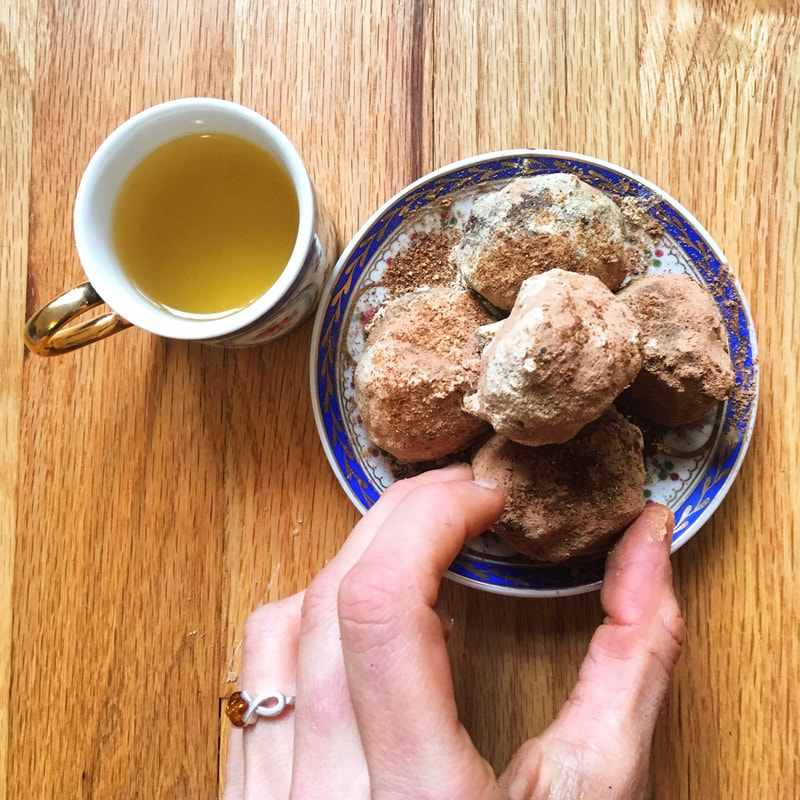 Our yin-yang fat balls balance the power of adaptogen in a delicious, fatty mixture (recipe below!) Our yin-yang fat balls balance the power of adaptogen in a delicious, fatty mixture (recipe below!) Ashwagandha (Withania somnifera, Solanaceae), for example, is an amazing adaptogen and incredibly popular these days (I find it on the shelves at TJ Maxx of all places!), but it is powerful and not for everyone. While herbs can be safe, herbs used improperly can hurt you. Ashwagandha is a very yang plant, energetically. By yang, we mean that it generates outward energy, as opposed to yin plants, that are more building, nourishing, and moistening in nature. Ashwagandha is warm, hot, and generates energy for work and endurance. This is why athletes love it so much. However, Ashwagandha might be too much for the average American who is already living a yang-dominant life, meaning they are always on the go and always exerting energy. Ashwagandha can also irritate hyperthyroid conditions, so you definitely want to stay away from this plant if you have any sort of high thyroid condition. Lastly, many people are sensitive to Nightshade plants, such as tomatoes, potatoes, and peppers. Ashwagandha is a Nightshade, so avoid this adaptogen if you have Nightshade-induced inflammation. For our fat balls, we balance the yang (think of the hot, drying outward energy of the sun as yang) power of Ashwagandha with the gently nourishing yin (think of the cool, moistening inward energy of the moon as yin) power of Shatavari (Asparagus racemosus, Liliaceae), a lesser-known but equally amazing adaptogen. Shatavari is generally "safer" than Ashwagandha for it doesn't directly influence the thyroid and it moistens and restores exhausted, dried out tissue. Our culture has enough outward, busy energy. Focusing on nourishing tissues by using more moistening Shatavari is a good practice for adaptogen use. We infuse our fat balls with the carminative, calming nature of Cardamom (Elettaria cardamomum, Zingiberaceae) and increase the bioavailabilty of our adaptogen medicine by decocting the powdered roots in coconut butter and grass-fed butter before making the batter. We hope you enjoy our recipe, and please leave your questions in the comment section below! Balanced Yin-Yang Fat Balls Ingredients
1/2 c Coconut oil, melted 1/4 c grassfed butter 1/4 c coconut butter 10 green cardamom pods (or 1 1/2 tsp cardamom powder) 1/3 c Shatavari powder 1 1/2 tbsp Ashwagandha 3 tbsp Red Reishi powder 1 cup coconut shreds (toasted if you prefer this taste over raw)1/2 c almond butter 1 cup raw cashews, soaked and toasted 2 tsp cinnamon 3 medjool dates (pitted) 1/3 c. almond or coconut milk pinch sea salt 1/2 cup dark chocolate chips 2 tbsp cacao nibs In a saucepan, heat up coconut oil, coconut butter, grass-fed butter, vanilla, cardamom + Ashwagandha, Shatavari, and Red Reishi powders. Bring to a slight simmer, stirring often. Let slightly simmer for about 5 minutes or until the butter is fragrant (this a crucial step to fully decoct all the medicine from the adaptogens). In a blender, pulse all the other ingredients except the milk, cacao nips and chocolate chips. Add the milk a little a time, scraping down the sides and processing until a sticky dough forms. Add the cooled, decocted adaptogen mixture. Transfer the mixture to a sealable container and refrigerate at least 2 hours (this makes it easier to form into balls later on). Once refridgerated, roll into 1" diameter balls, coating in cocoa powder, extra Shatavari powder, or coconut shreds for a decorative touch. I like to sprinkle with a bit more sea salt. In an airtight container, keep in the refrigerator for up to 10 days or in the freezer for up to 2 months Coconut Mustard Aioli:
|
Eileen Brantley & Amy WrightWe are Herb Girls Athens, LLC. Read our blog! Archives
November 2022
Categories
All
|

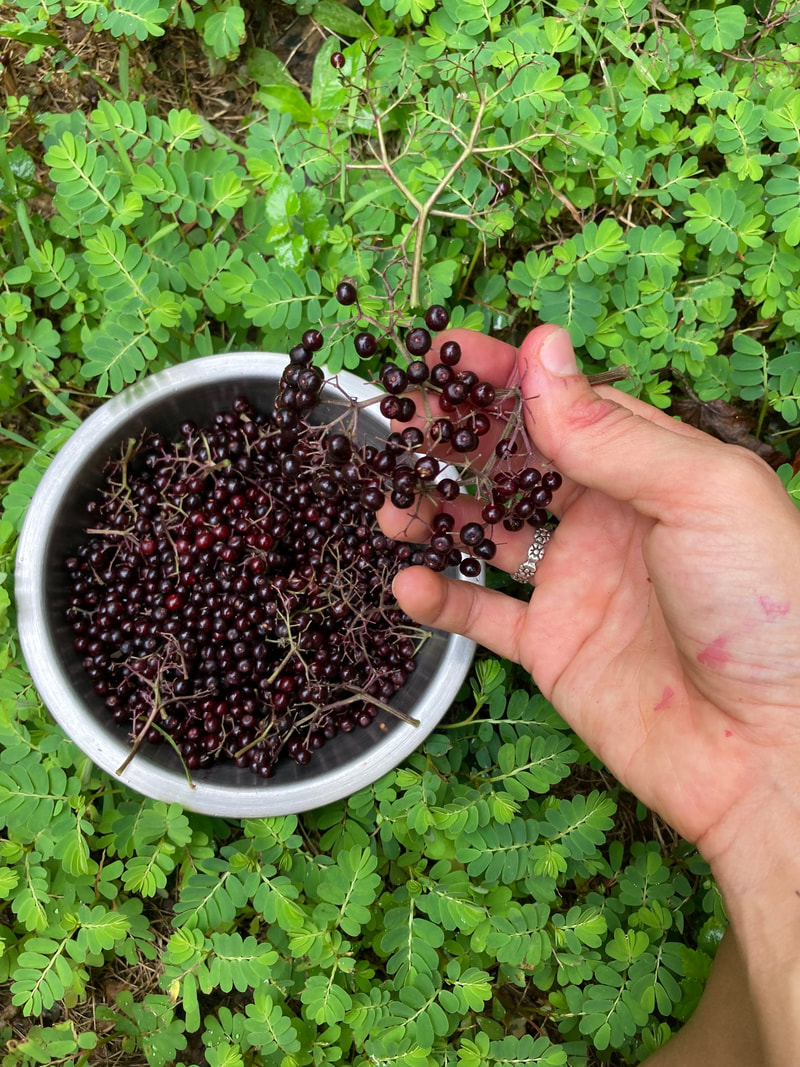
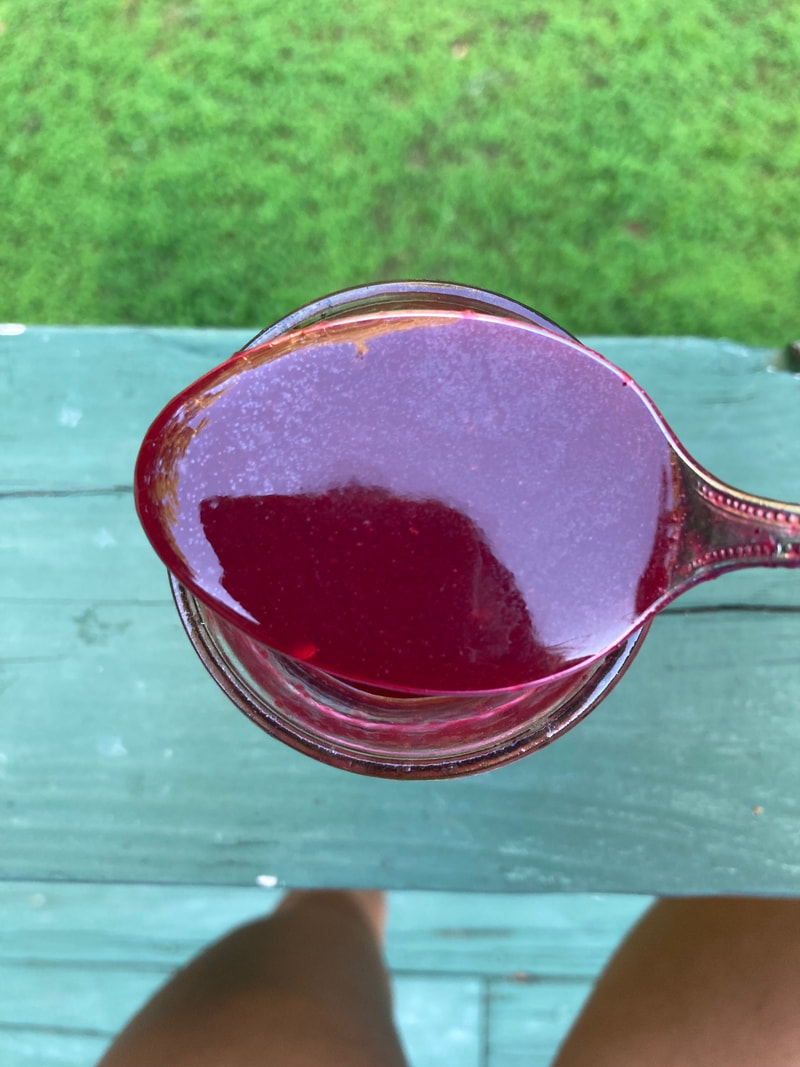
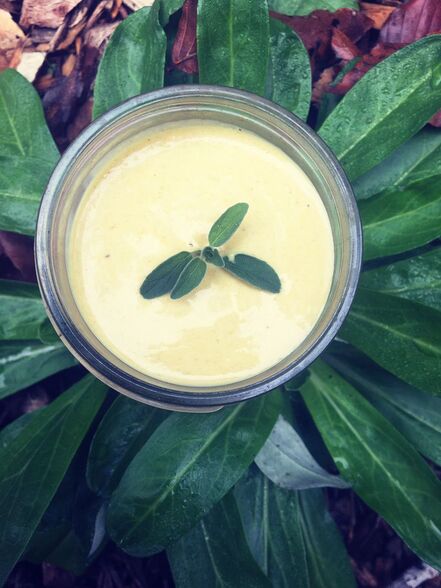
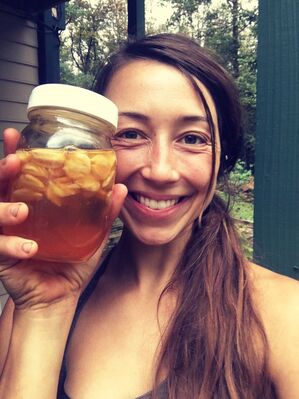
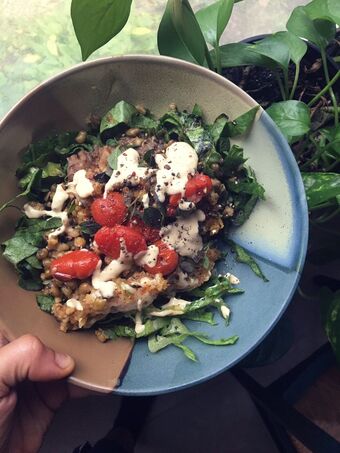
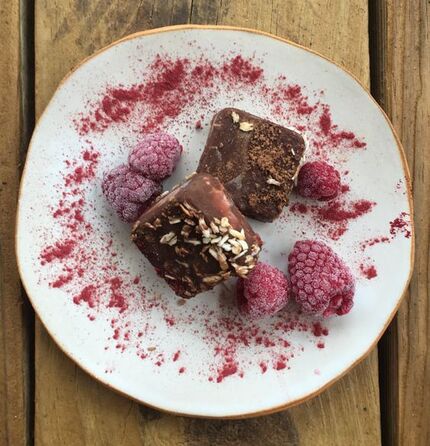
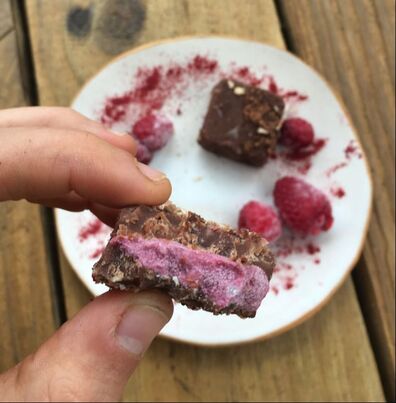
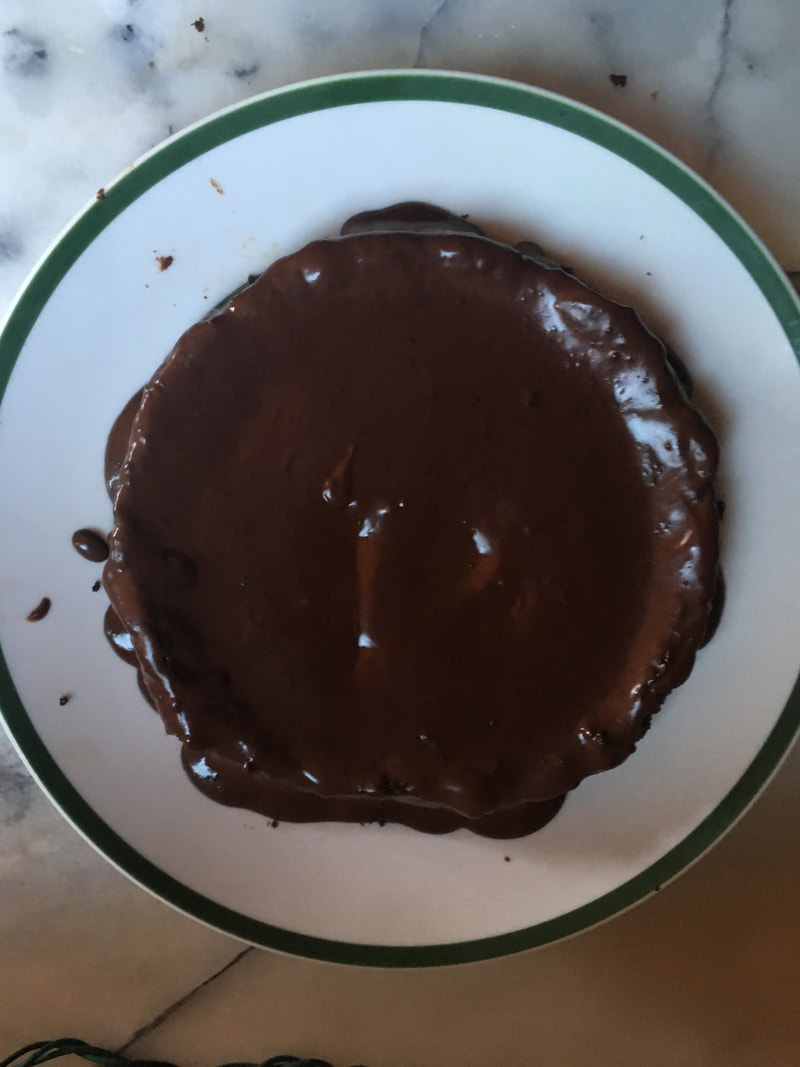


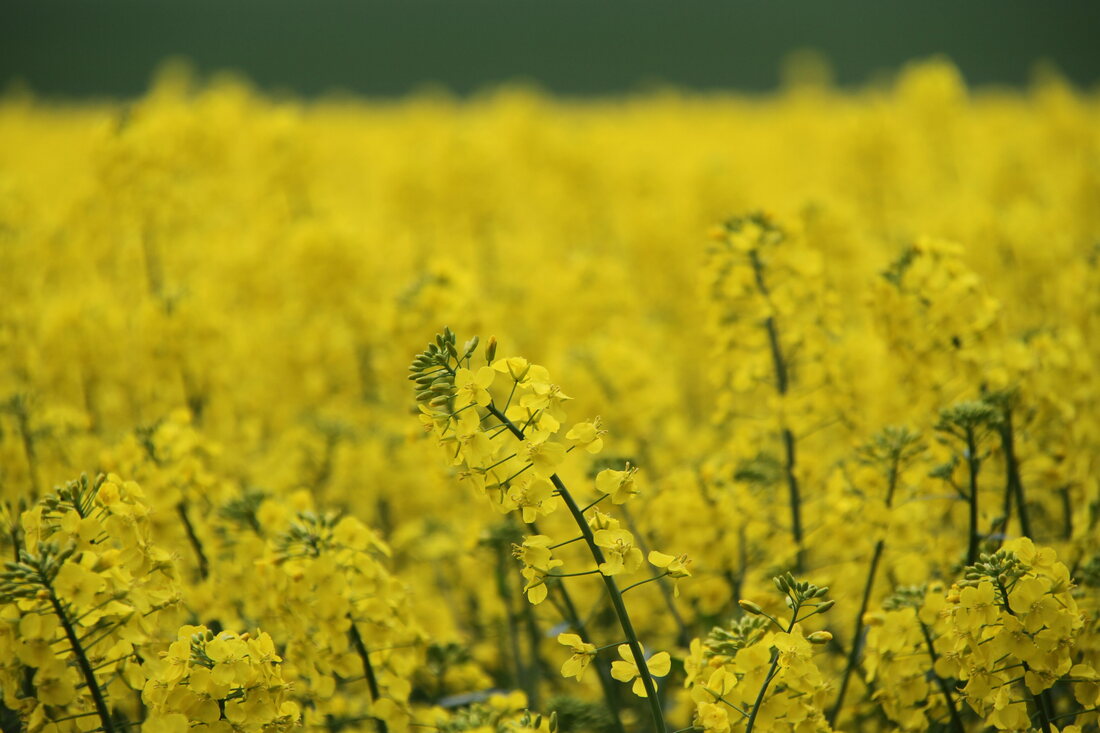

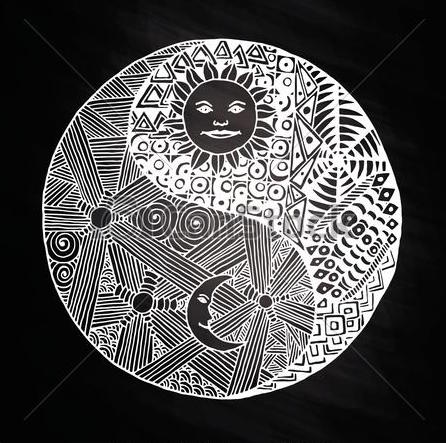
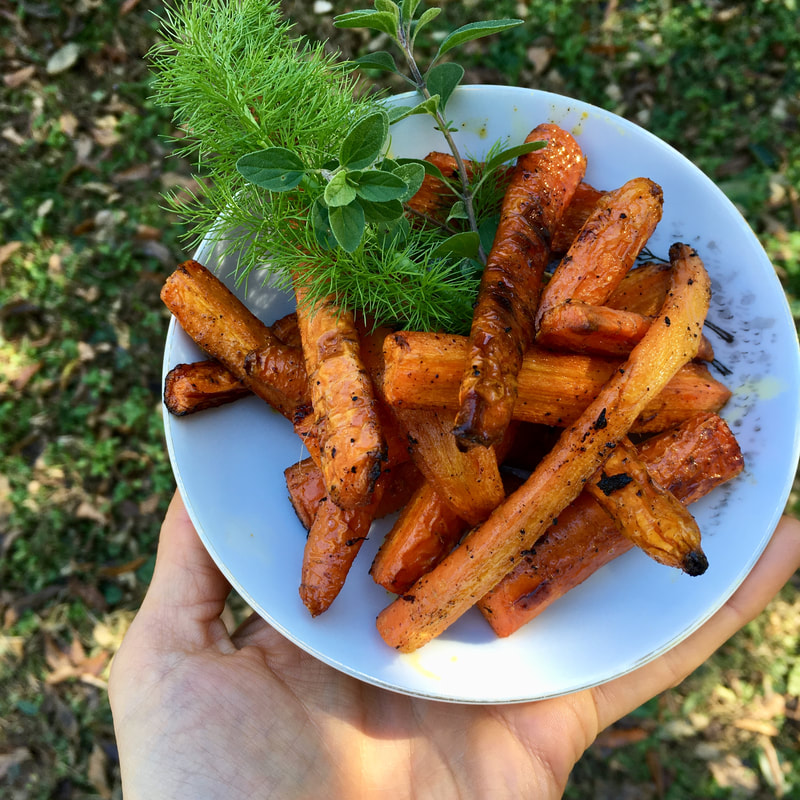
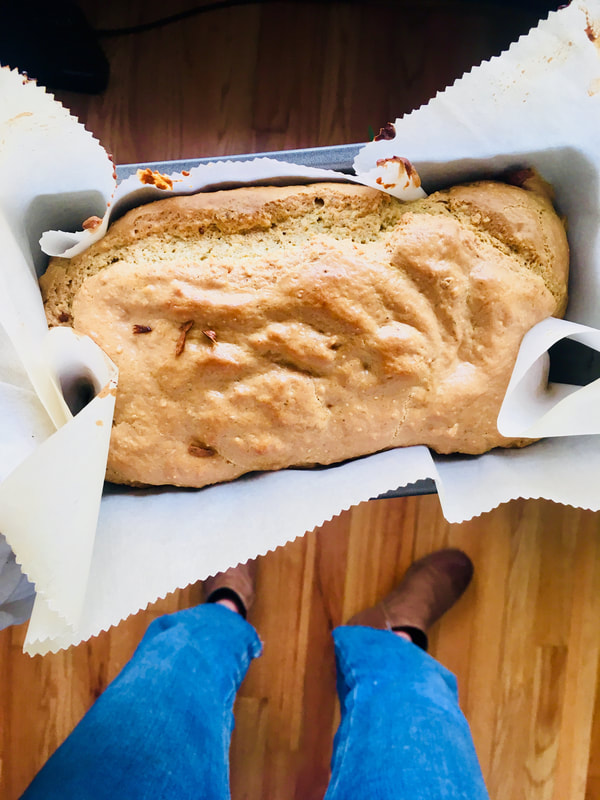
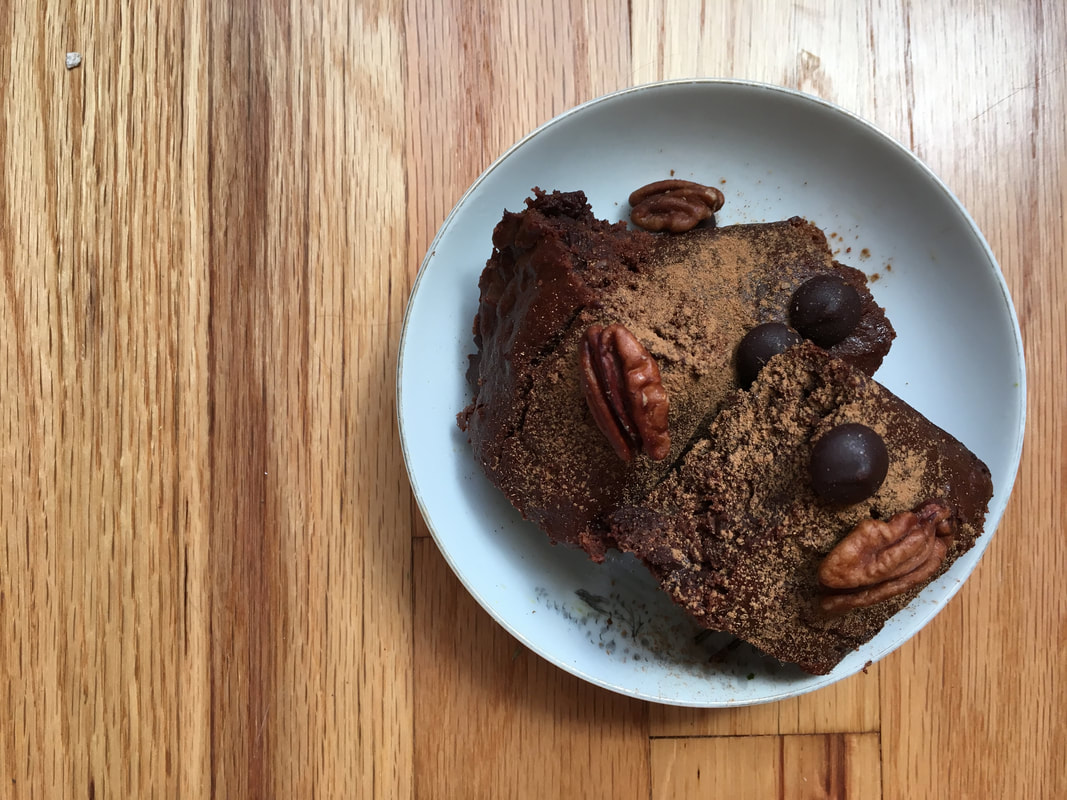

 RSS Feed
RSS Feed
